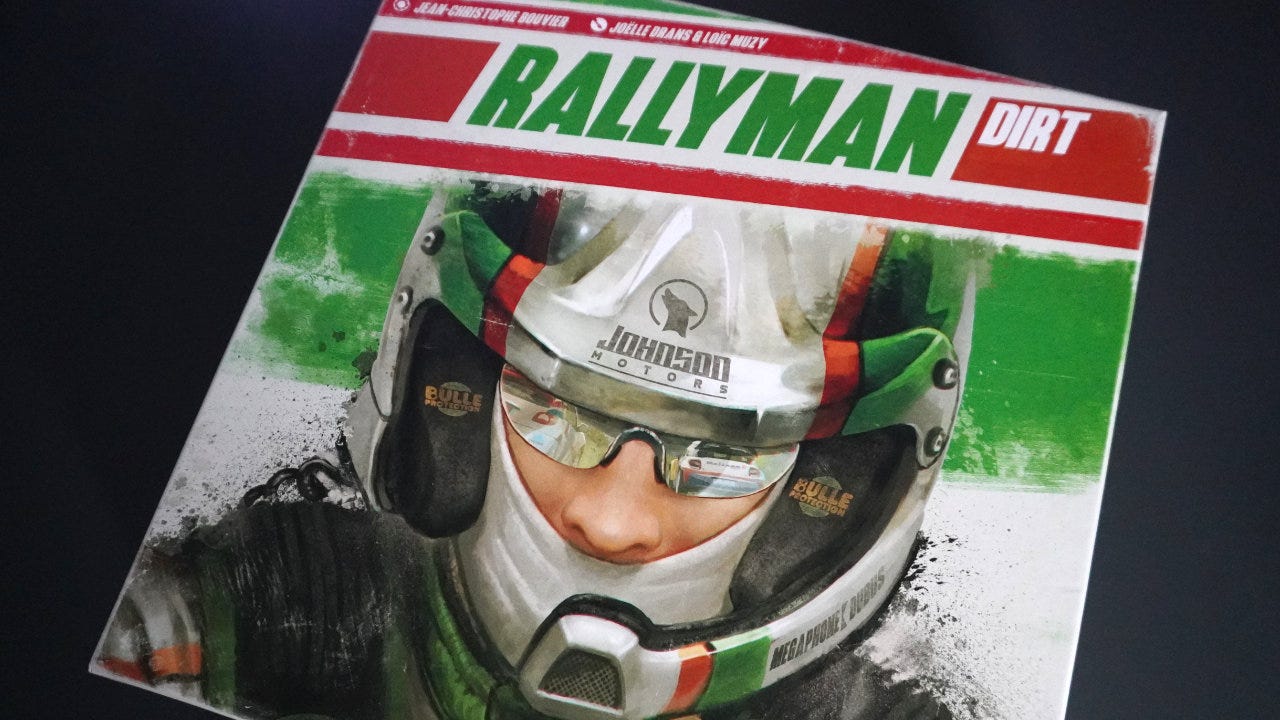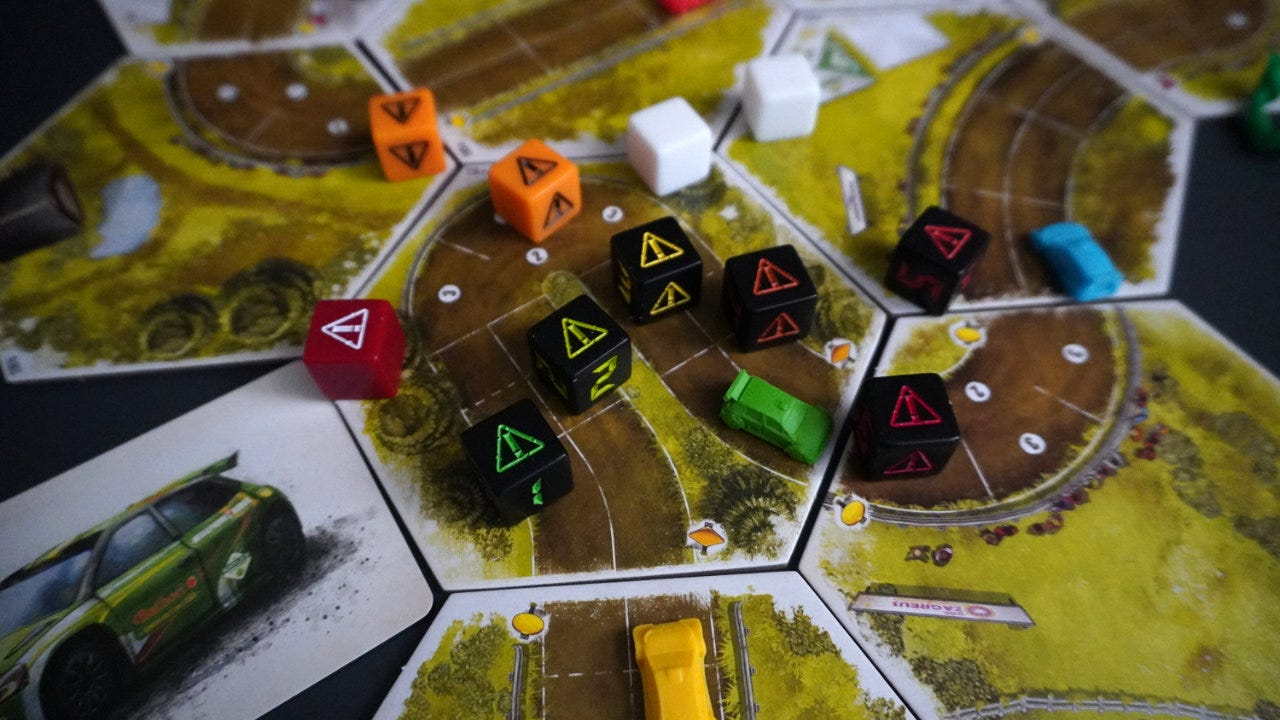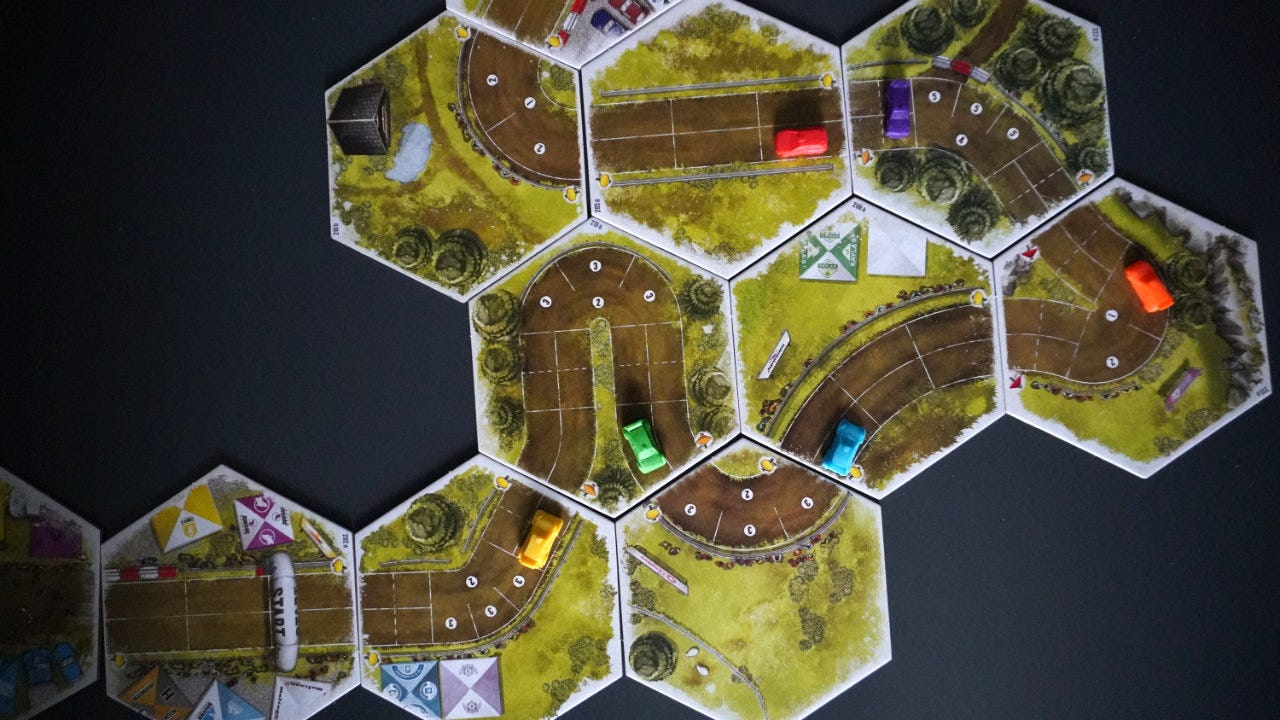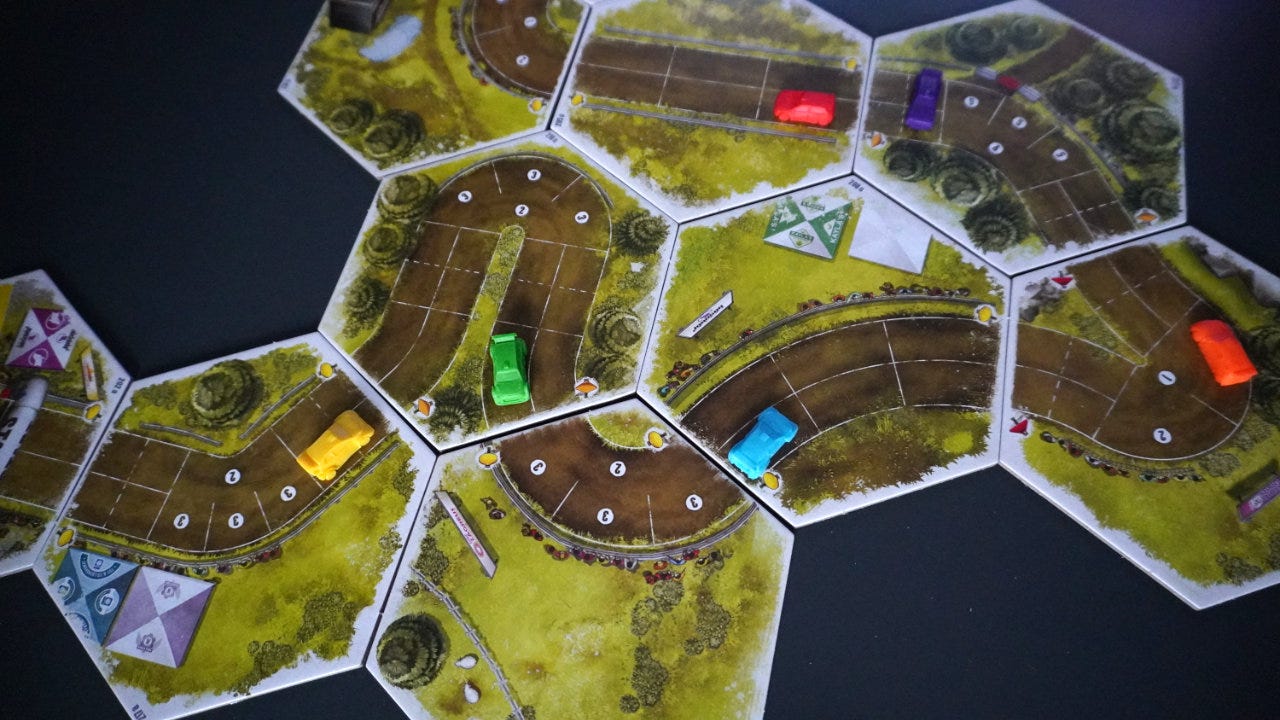Dirt and speed... flat out!
Exploring the "flat out" push your luck mechanism in Rallyman: DIRT and why you should look at the entire mechanism when making something new.
Welcome to Skeleton Code Machine, an ENNIE-nominated and award-winning weekly publication that explores tabletop game mechanisms. Check out Public Domain Art and Fragile Games to get started. Subscribe to TUMULUS to get more design inspiration delivered to your door each quarter!
Last week we explored combat encounters where even the loser gets a reward in Crown of Ash, and how this might reduce loss aversion effects in tabletop games.
This week we are looking at a specific push your luck mechanism in Rallyman: DIRT.
But first…
⚔️ Make your own TTRPG adventure!
Pre-orders are open for ADVENTURE! Make Your Own TTRPG Adventure — a new guide from Skeleton Code Machine.1 Using MÖRK BORG’s Rotblack Sludge as inspiration, you’ll learn how to craft hooks, rumors, encounters, and more. The hands-on exercises will take you from blank paper to finished adventure.
Rallyman: Dirt
Rallyman: DIRT (Bouvier, 2022) is a reimplementation of the original Rallyman (2009) and Rallyman: GT (2009) games.2 This edition is about racing supercharged rally cars on dirt tracks. Like actual rally racing, the goal is to get the best time through each stage, not necessarily cross the actual finish line first. It adds water hazards, jumps, and drifting around corners to a base game that is similar to Rallyman: GT.
Tracks are created using large, beautifully illustrated hexagonal road tiles — corners, hairpins, straight sections, and other variations.
It’s a time trial race, so cars aren’t fighting for the same positions on the track. Instead it uses a staggered start where the first player takes more turns early in the game to spread everyone out. Then players take turns rolling dice, moving their cars, and accumulating “time cards” that will be added to determine their finish time.
Gear dice
I want to focus on a single push your luck mechanism in Rallyman: DIRT, but to do that we need to understand how the gear dice work.
There are six gear dice, numbered 1 (slowest) to 6 (fastest) which represent your car’s gear and speed. Each has a number of hazard (⚠️) symbols on it, with more hazards on the higher gears (e.g. 1 hazard on the 1 & 2 dice, and 2 hazards on the 3, 4, 5, 6 dice). There are also coast (white) and brake (red) dice.
Players choose and position gear dice on the track at the start of their turn showing the path of their rally car. Dice must always be placed in ascending or descending order (e.g. 2, 3, 4, 5 or 6, 5, 4, 3). Various speed limits for turns, jumps, and other hazards complicate this selection. After choosing, they roll the dice to see how they did.
If they ever roll hazards equal to the hazard limit on their dashboard (usually 3), they suffer a loss of control — their car spins off the track. Otherwise, they move ahead, collect a time card, and play passes to the next player.
Flat out
Players have two options for rolling their gear dice:
One by One: Roll one die at a time, checking for hazards, and stopping at any time. This allows players to exercise caution once they hit 2 of their 3 hazards, perhaps deciding they have gone far enough.
Flat out: Roll all the dice at once and hope for the best! You still lose control if you hit 3 hazards, but that risk comes with quite a reward. Survive the roll and you not only move ahead on the track, you’ll gain Second Tokens that can be used to “secure” dice when rolling One by One (preventing hazards) or shave time off your final score for the stage.
It presents an interesting choice to the player. Taking a cautious turn at lower gears means you have a better chance of surviving a flat out attempt — gaining precious Second Tokens that will be useful later. Being too cautious, however, results in more turns to get to the finish line, more time cards, and a worse finish time.
The pressure is always there to push your luck with a flat out even at higher gears, hoping you can make it.
Rewarding players with luck mitigation
Rallyman: DIRT isn’t what I’d consider a deep strategy game. It’s a relatively short dice chucking fun time. It is entirely possible to just have the dice hate you for a game and prevent you from winning. That said, the flat out mechanism is a really interesting luck mitigation method.
While many push your luck games reward the player with more end-game victory points, Rallyman: DIRT rewards the player with the ability to mitigate future dice rolls and potential bad luck. The player receives one Seconds Token for each gear die rolled when going flat out — roll 5 dice, succeed, and get 5 Seconds Tokens.
Those tokens can be used to “secure” future gear dice — prevent them from being rolled and ensure they won’t be a hazard. In a tight game where every turn matters, being able to secure (i.e. not roll) the last two dice of a turn is huge.
It makes every turn a tough decision.
Alternate dice pool rolling methods
Many TTRPGs use dice pool systems for resolving actions, and it’s one of my favorite methods. It’s extremely common, however, that all the dice in the pool are rolled at the same time. Either the pool is of fixed size, or perhaps you modify the pool for that action, but it is the pool that is changed and not the rolling method.
It is particularly novel how Rallyman: DIRT holds the dice pool constant (i.e. always the same dice to choose from) and instead has the player choose how to roll them.
I have a game buried in my notebook that uses push your luck combat mechanisms inspired by Rallyman: GT, Rallyman: DIRT, and Trick Shot (Nichipurov, 2012). These style mechanisms are just begging to be adopted into TTRPGs.
Conclusion
Some things to think about:
Think about the entire mechanism: Dice pools mechanisms are often modified by how the pool is created, which dice are rolled, and things at that end of the process. The dice pool mechanism, however, continues all the way through to the end of the dice resolution. Think about the entire process and you can see that an opportunity exists to modify both the pool building and the dice rolling.
Racing games aren’t just board games: For a perfect example, check out the Skeleton Code Machine article on Torq by Will Jobst.
Custom dice vs. regular dice: Rallyman: DIRT uses custom dice that are color coded and have hazard symbols on them. The exact mechanism could be implemented, however, with regular dice where the 6 is a hazard on some and the 5 & 6 are hazards on others.
What do you think? Does the flat out mechanism sound like fun? Have you seen something like this in TTRPGs?
— E.P. 💀
P.S. Get ADVENTURE! Make Your Own TTRPG Adventure from Skeleton Code Machine with art by Evlyn Moreau. Pre-orders bundles include the adventures used as examples in the book!
Skeleton Code Machine is a production of Exeunt Press. All previous posts are in the Archive on the web. Subscribe to TUMULUS to get more design inspiration. If you want to see what else is happening at Exeunt Press, check out the Exeunt Omnes newsletter.
The pre-order bundle includes the adventures that are used as examples in the book — Hammer of a Killing Crown, Invitation to a Dark Masquerade, and A Pale Ground Covering All. After the pre-order period, ADVENTURE! will be available in print separately. If you only want the PDF, you can get that right now at itch.io.
I feel the need to at least mention that Rallyman: DIRT was originally on Kickstarter where 4,567 backers pledged €387,919. Holy Grail Games then never delivered, declared they were shutting down, and to my knowledge backers have still never received anything. Games were produced and ended up in the retail market, so you might see a copy at your FLGS.









Our games have had a small player count so far, but I do wonder how things may change with more players. Blocking has been useful at least once to force a player that had lost control to automatically take another minute at gear zero. Going flat out has also been strategically useful and it's fun to roll a bunch of dice all at once. We will see what other interesting strategies we can discover soon. Cheers!
Hey, just wanted to say thank you for helping me discover new fun games and mechanics. I really like the analyses that you write and this one got me to try Rallyman:DIRT. Had some fun playing this with my brother and wife and we already scheduled another rally.